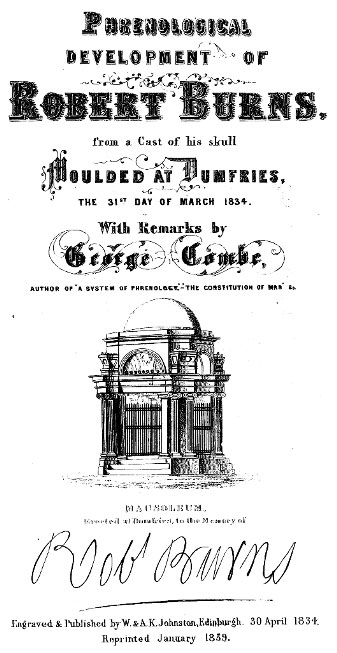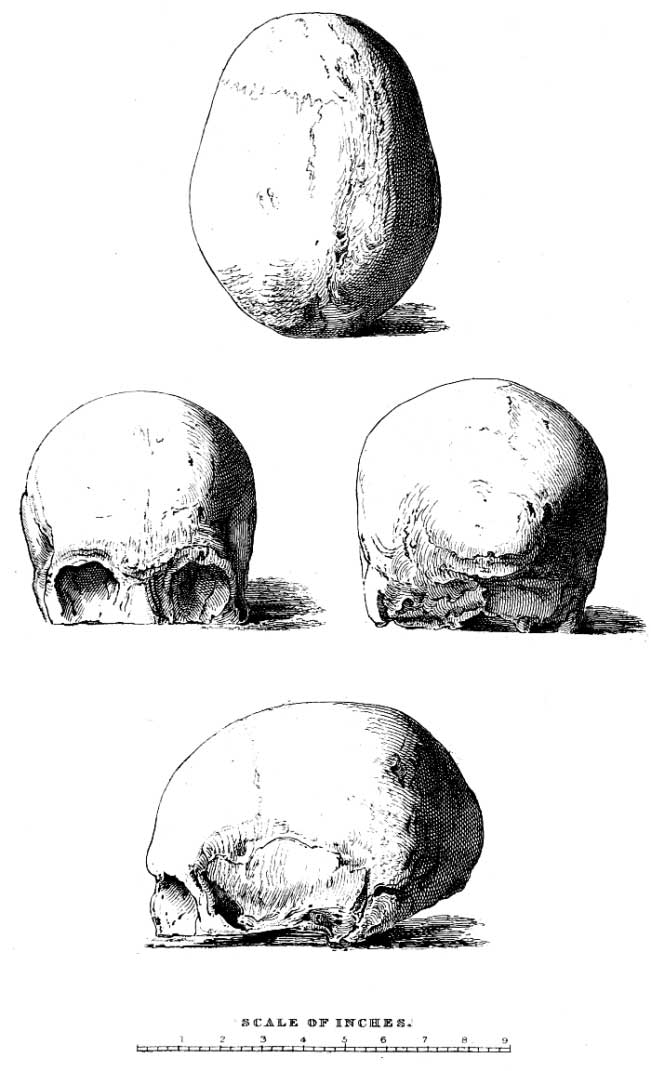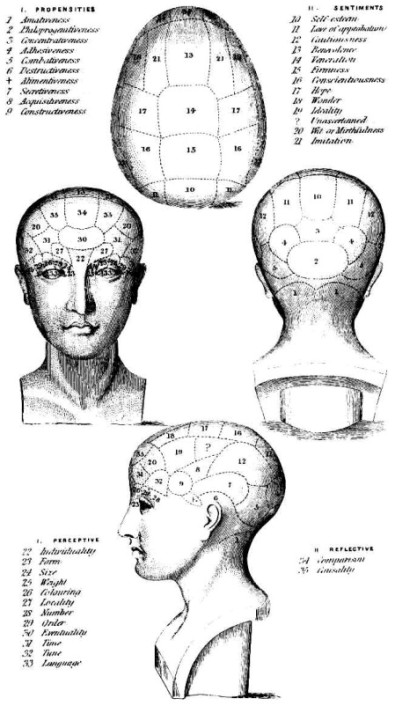

[Pg 1]

[Pg 2]

VIEWS OF THE SKULL OF ROBERT BURNS.
[Pg 2]

KEY TO THE PHRENOLOGICAL ORGANS.
[Pg 4]
Robert Burns was born on 25th January 1759, and died at Dumfries on 21st July 1796, in the 37th year of his age, and, on the 26th, was interred in St Michael's Churchyard. Eighteen years afterwards, a Mausoleum was erected by subscription to his memory in that cemetery; and, on the 19th September 1815, his remains were privately exhumed and transferred to the vault attached to it. Mrs Burns, the Poet's widow, having died on 26th March 1834, the vault was opened for the purpose of depositing her remains beside those of her husband; and the gentlemen who took charge of the proceedings, being aware of the anxiety which had long been generally felt to obtain a Cast of the Poet's Skull, resolved to avail themselves of the opportunity to gratify this desire. The consent of the relatives having been obtained, Mr M'Diarmid, the Editor of the Dumfries Courier, went with several other gentlemen to the vault, and successfully effected their purpose.
The following description is written by Mr Archibald Blacklock, Surgeon: "The cranial bones were perfect in every respect, if we except a little erosion of their external table, and firmly held together by their sutures; even the delicate bones of the orbits, with the trifling exception of the os unguis in the left, were sound and uninjured by death and the grave. The superior maxillary bones still retained the four most posterior teeth on each side, including the dentes sapientiæ, and all without spot or blemish; the incisores, cuspidati, &c., had, in all probability, recently dropped from the jaw, for the alveoli were but little decayed. The bones of the face and palate were also sound. Some small portions of black hair, with a very few grey hairs intermixed, were observed while detaching some extraneous matter from the occiput. Indeed, nothing could exceed the high state of preservation in which we found the bones of the cranium, or offer a fairer opportunity of supplying what has so long been desiderated by Phrenologists—a correct model of our immortal Poet's head; and in order to accomplish this in the most accurate and satisfactory manner, every particle of sand or other foreign body was carefully washed off, and[Pg 5] the plaster-of-Paris applied with all the tact and accuracy of an experienced artist. The Cast is admirably taken, and cannot fail to prove highly interesting to Phrenologists and others.
"Having completed our intention, the Skull, securely enclosed in a leaden case, was again committed to the earth precisely where we found it.
"Archd. Blacklock."
Dumfries, 1st April 1834.
| Inches. | ||
| Greatest circumference, | 22¼ | |
| From | Occipital Spine to Individuality, over the top of the head, | 14 |
| ... | Ear to Ear vertically over the top of the head, | 13 |
| ... | Philoprogenitiveness to Individuality (greatest length), | 8 |
| ... | Concentrativeness to Comparison, | 7⅛ |
| ... | Ear to Philoprogenitiveness, | 4⅞ |
| ... | Ear to Individuality, | 4¾ |
| ... | Ear to Benevolence, | 5½ |
| ... | Ear to Firmness, | 5½ |
| ... | Destructiveness to Destructiveness, | 5¾ |
| ... | Secretiveness to Secretiveness, | 5⅞ |
| ... | Cautiousness to Cautiousness, | 5½ |
| ... | Ideality to Ideality, | 4⅝ |
| ... | Constructiveness to Constructiveness, | 4½ |
| ... | Mastoid process to Mastoid process, | 4¾ |
| Scale. | ||
| 1. | Amativeness, rather large, | 16 |
| 2. | Philoprogenitiveness, very large, | 20 |
| 3. | Concentrativeness, large, | 18 |
| 4. | Adhesiveness, very large, | 20 |
| 5. | Combativeness, very large, | 20 |
| 6. | Destructiveness, large, | 18 |
| 7. | Secretiveness, large, | 19 |
| 8. | Acquisitiveness, rather large, | 16 |
| 9. | Constructiveness, full, | 15 |
| 10. | Self-Esteem, large, | 18 |
| 11. | Love of Approbation, very large, | 20 |
| 12. | Cautiousness, large, | 19 |
| 13. | Benevolence, very large, | 20 |
| 14. | Veneration, large, | 18 |
| 15. | Firmness, full, | 15 |
| 16. | Conscientiousness, full, | 15 |
| 17. | Hope, full, | 14 |
| 18. | Wonder, large, | 18 |
| 19. | Ideality, large, | 18 |
| 20. | Wit, or Mirthfulness, full, | 15 |
| 21. | Imitation, large, | 19 |
| 22. | Individuality, large, | 19 |
| 23. | Form, rather large, | 16 |
| 24. | Size, rather large, | 17 |
| 25. | Weight, rather large, | 16 |
| 26. | Colouring, rather large, | 16 |
| 27. | Locality, large, | 18 |
| 28. | Number, rather full, | 12 |
| 29. | Order, full, | 14 |
| 30. | Eventuality, large, | 18 |
| 31. | Time, rather large, | 16 |
| 32. | Tune, full, | 15 |
| 33. | Language, uncertain, | |
| 34. | Comparison, rather large, | 17 |
| 35. | Causality, large, | 18 |
The scale of the organs indicates their relative proportions to each
other;
2 is Idiotcy—10 Moderate—14 Full—18 Large—and 20 very Large.
The cast of a Skull does not show the temperament of the individual, but the portraits of Burns indicate the bilious and nervous temperaments—the sources of strength, activity, and susceptibility; and the descriptions given by his contemporaries of his beaming and energetic eye, and the rapidity and impetuosity of his manifestations, establish the inference that his brain was active and susceptible.
[Pg 6]Size in the brain, other conditions being equal, is the measure of mental power. The Skull of Burns indicates a large brain. The length is 8, and the greatest breadth nearly 6 inches. The circumference is 22¼ inches. These measurements exceed the average of Scotch living heads, including the integuments, for which four-eighths of an inch may be allowed.
The brain of Burns, therefore, possessed the two elements of power and activity.
The portions of the brain which manifest the animal propensities are uncommonly large, indicating strong passions, and great energy in action under their influence. The group of organs manifesting the domestic affections (Amativeness, Philoprogenitiveness, and Adhesiveness), is large; Philoprogenitiveness uncommonly so for a male head.
The organs of Combativeness and Destructiveness are large, bespeaking great heat of temper, impatience, and liability to irritation.
Secretiveness and Cautiousness are both large, and would confer considerable power of restraint, where he felt restraint to be necessary.
Acquisitiveness, Self-Esteem, and Love of Approbation, are also in ample endowment, although the first is less than the other two; these feelings give the love of property, a high consideration of self, and desire of the esteem of others. The first quality will not be so readily conceded to Burns as the second and third, which, indeed, were much stronger; but the Phrenologist records what is presented by nature, in full confidence that the manifestations, when the character is correctly understood, will be found to correspond with the development, and he states that the brain indicates considerable love of property.
The organs of the moral sentiments are also largely developed. Ideality, Wonder, Imitation, and Benevolence, are the largest in size. Veneration also is large. Conscientiousness, Firmness, and Hope, are full.
The Knowing organs, or those of perceptive intellect, are large; and the organs of Reflection are also considerable, but less than the former. Causality is larger than Comparison, and Wit is less than either.
The Skull indicates the combination of strong animal passions, with equally powerful moral emotions. If the natural morality had been less, the endowment of the propensities is sufficient to have constituted a character of the most desperate description. The combination, as it exists, bespeaks a mind extremely subject to contending emotions—capable of great good or great evil—and encompassed with vast difficulties in preserving a steady, even, onward course of practical morality.
In the combination of very large Philoprogenitiveness and Adhesiveness, with very large Benevolence and large Ideality, we find the elements of that exquisite tenderness and refinement, which Burns so frequently manifested, even when at the worst stage of his career. In the combination of great Combativeness, Destructiveness, and Self-Esteem, we find the fundamental qualities which inspired "Scots wha hae wi' Wallace bled," and similar productions.
The combination of large Secretiveness, Imitation, and the Perceptive[Pg 7] organs, gives the elements of his dramatic talent and humour. The Skull indicates a decided talent for Humour, but less for Wit. The public are apt to confound the talents for Wit and Humour. The metaphysicians, however, have distinguished them, and in the phrenological Works their different elements are pointed out. Burns possessed the talent for satire: Destructiveness, added to the combination which gives Humour, produces it.
An unskilful observer looking at the forehead might suppose it to be moderate in size; but when the dimensions of the anterior lobe, in both length and breadth, are attended to, the Intellectual organs will be recognised to have been large. The anterior lobe projects so much that it gives an appearance of narrowness to the forehead which is not real. This is the cause, also, why Benevolence appears to lie farther back than usual. An anterior lobe of this magnitude indicates great Intellectual power. The combination of large Perceptive and Reflecting organs (Causality predominant), with large Concentrativeness and large organs of the feelings, gives that sagacity and vigorous common sense for which Burns was distinguished.
The Skull rises high above Causality, and spreads wide in the region of Ideality; the strength of his moral feelings lay in that region.
The combination of large organs of the Animal Propensities, with large Cautiousness, and only full Hope, together with the unfavourable circumstances in which he was placed, accounts for the melancholy and internal unhappiness with which Burns was so frequently afflicted. This melancholy was rendered still deeper by bad health.
The combination of Acquisitiveness, Cautiousness, Love of Approbation, and Conscientiousness, is the source of his keen feelings in regard to pecuniary independence. The great power of his Animal Propensities would give him strong temptations to waste; but the combination just mentioned would impose a powerful restraint. The head indicates the elements of an economical character; and it is known that he died free from debt, notwithstanding the smallness of his salary.
No Phrenologist can look upon this head, and consider the circumstances in which Burns was placed, without vivid feelings of regret. Burns must have walked the earth with a consciousness of great superiority over his associates in the station in which he was placed—of powers calculated for a far higher sphere than that which he was able to reach—and of passions which he could with difficulty restrain, and which it was fatal to indulge. If he had been placed from infancy in the higher ranks of life, liberally educated, and employed in pursuits corresponding to his powers, the inferior portion of his nature would have lost part of its energy, while his better qualities would have assumed a decided and permanent superiority.
The Drawings of the Skull are ably executed by George Harvey, Esq., S.A.
Cover Text
Phrenological
DEVELOPMENT
of
Robert Burns
BY
George Combe.
Engraved & Published by W. & A.K. Johnston, Edinburgh. April 1834.
REPRINTED JANUARY 1859.
Title Page Text
Phrenological
DEVELOPMENT OF
Robert Burns,
from a Cast of his skull
Moulded at Dumfries.
THE 31ST DAY OF MARCH 1834.
With Remarks by
George Combe,
AUTHOR OF "A SYSTEM OF PHRENOLOGY,"—"THE CONSTITUTION OF MAN" &c.
MAUSOLEUM,
Erected at Dumfries, to the Memory of
Robt Burns
Engraved & Published by W. & A.K. Johnston, Edinburgh 30 April 1834.
Reprinted January 1859.